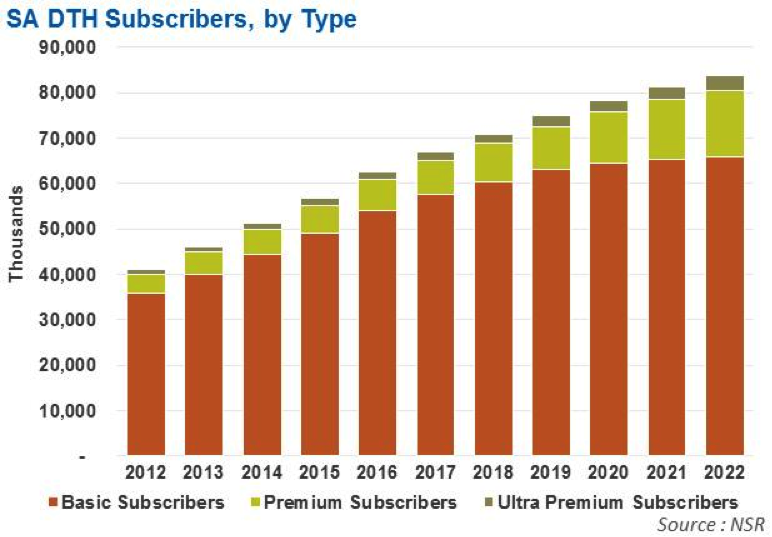Changes in the Most
Dynamic DTH Market
Aug 27th, 2013 by
Blaine Curcio, Nsr
With the recent announcement
of a proposed merger between
Reliance Digital and Sun Direct,
which would form India’s 2nd
largest DTH platform, the
world’s most dynamic DTH market
has kicked it up a notch. With 5
major platforms jostling over
1.1 billion people, the Indian
DTH market is transitioning from
being characterized by breakneck
subscriber growth to more
nuanced subscriber retention and
development.
As the market continues to
grow at a considerable clip,
there will be several key
concepts to grasp in order to
capitalize on this growth—the
fundamentally unique aspects of
the Indian market, the way in
which operators are trying to
retain existing customers, and
the future direction of the
industry following
digitalization.
The Indian DTH market is by
no means unique among developing
economies, in the sense that a
high percentage of Indian DTH
subscribers are pre-paid and
short-term. However, it is a
unique market when considering
the sheer number of these types
of subscribers, which themselves
outnumber the DTH subs in most
countries. NSR’s
Direct-to-Home Markets, 6th
Edition estimates that
there are around 40 million DTH
subscribers in India as of 2012,
making it the largest DTH market
in the world by subscribers.
However, many published articles
and press releases would put the
number at around 60 million
subscribers. This difference of
around 20 million represents a
sea of short-term, pre-paid
customers, who are currently
inactive. Moving forward, it
will be critical for Indian
operators to tap into this
customer segment and up their
retention rate, for these people
have already made the effort to
get satellite TV, and thus are
considerably more likely to be
long-term customers. Platforms
are employing an arsenal of
different tools to help retain
these customers, and eventually
grow their ARPUs.
Platforms up to this point
have used a number of
promotional strategies to lure
customers into the DTH market,
which include 3 free months of
service, buy a 1-year contract
and receive 2 months free, etc.
While these offers have helped
to boost customer retention,
subscriber churn remains the
single biggest issue among
operators, in some cases
reaching as high as 35%.
In NSR’s view, the Indian DTH
market requires further
granularity of product
offerings. In a country and an
economy as diverse as India’s,
customization is a must. This
business model has proven very
successful for other firms
within India, most notably
Samsung, who has recently
unseated Nokia in mobile phone
sales in India. A large driver
of this success is Samsung’s
diverse product offering—for
example, they sell 10 different
phones priced between $16US and
$31US, each with a few more
features. DTH operators could
and should learn from this
example, by offering a diverse
array of services allowing
customers to marginally upgrade
content for a minimal added
cost, thus helping them move up
the ARPU chain.
As the digitalization process
continues in India, nearly 100M
new households will become
digital by EoY2014. DTH holds a
geographical advantage over
cable in signing up these new
households, due to their
tendency to be located in rural
areas where cable is
prohibitively expensive to
install. However, with more lax
controls over payment and
content viewing, cable does have
a competitive advantage over
DTH, particularly among India’s
most poverty-stricken regions.
Overall, for DTH operators to
capture a large share of the
newly digitized households in
the coming years, they will need
to combine their existing core
competencies of better customer
service and quality of product
with a more diverse product
offering. This will lead to
meager profit margins for the
short-term, but place them in
better position for long-term
sustained growth in the world’s
most dynamic DTH market.

Bottom Line
NSR’s Global
Direct-to-Home Markets, 6th
Edition projects a global
addition of just over 124M DTH
subscribers by 2022. Of this
number, nearly 45 million
will come from South Asia, of
which the overwhelming majority
will be in India. By changing
focus from customer acquisition
to building customer ARPUs, DTH
platforms are changing the
market landscape. With a variety
of options at their disposal, it
is in NSR’s view that the most
effective method of building
ARPUs will be granular
subscription options, allowing
customers to slowly and cheaply
add a few more channels. As
digitalization continues to
march across the subcontinent,
DTH platforms need to rely on
their core competencies while
also stemming the tide against
cable, particularly by
leveraging their accessibility
in rural areas. Bottom line,
growth, as well as competition,
will be fierce in the coming
years in India, and it is up to
DTH platforms to capitalize on
the development of the country
and its populace.
|